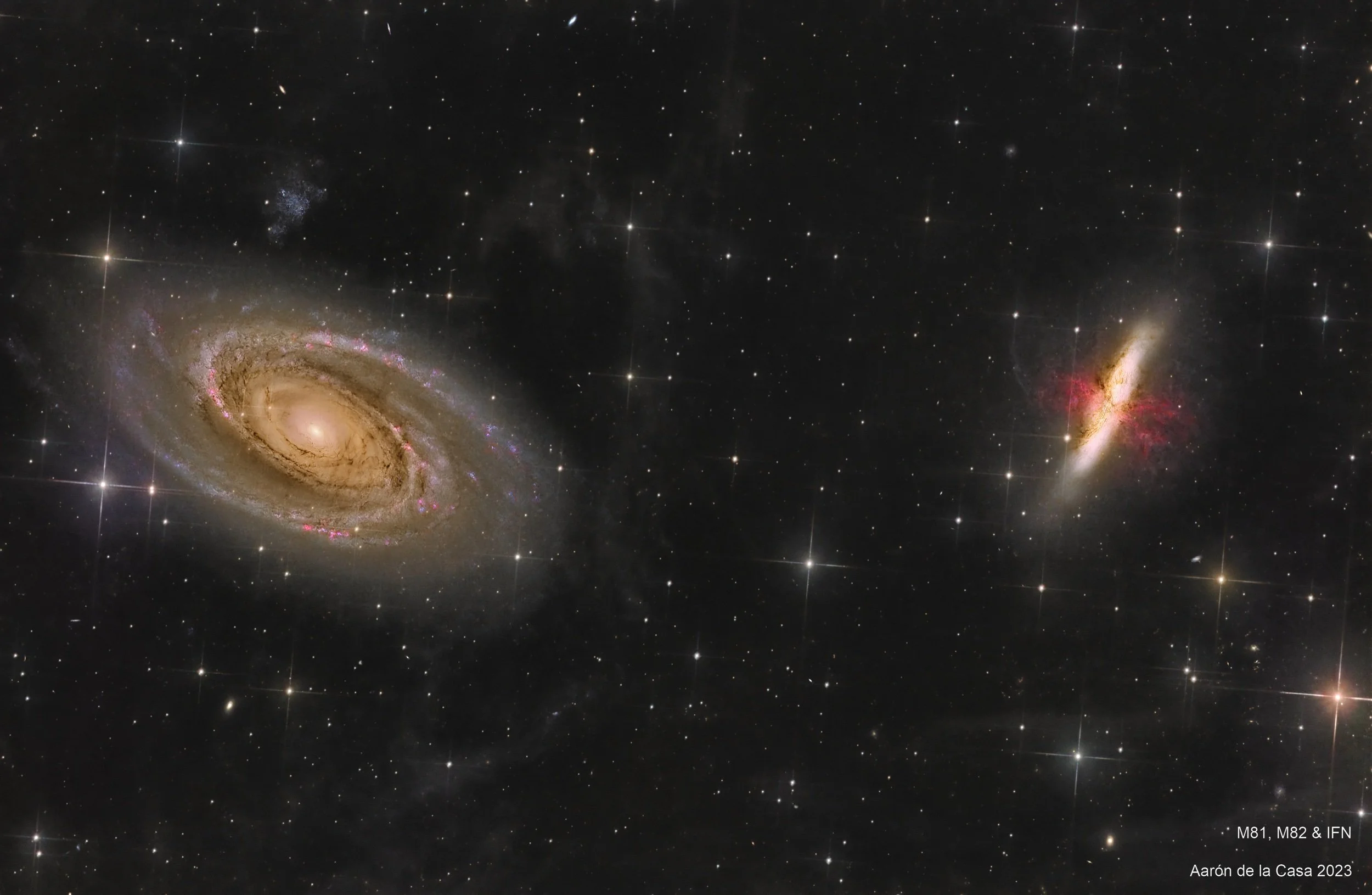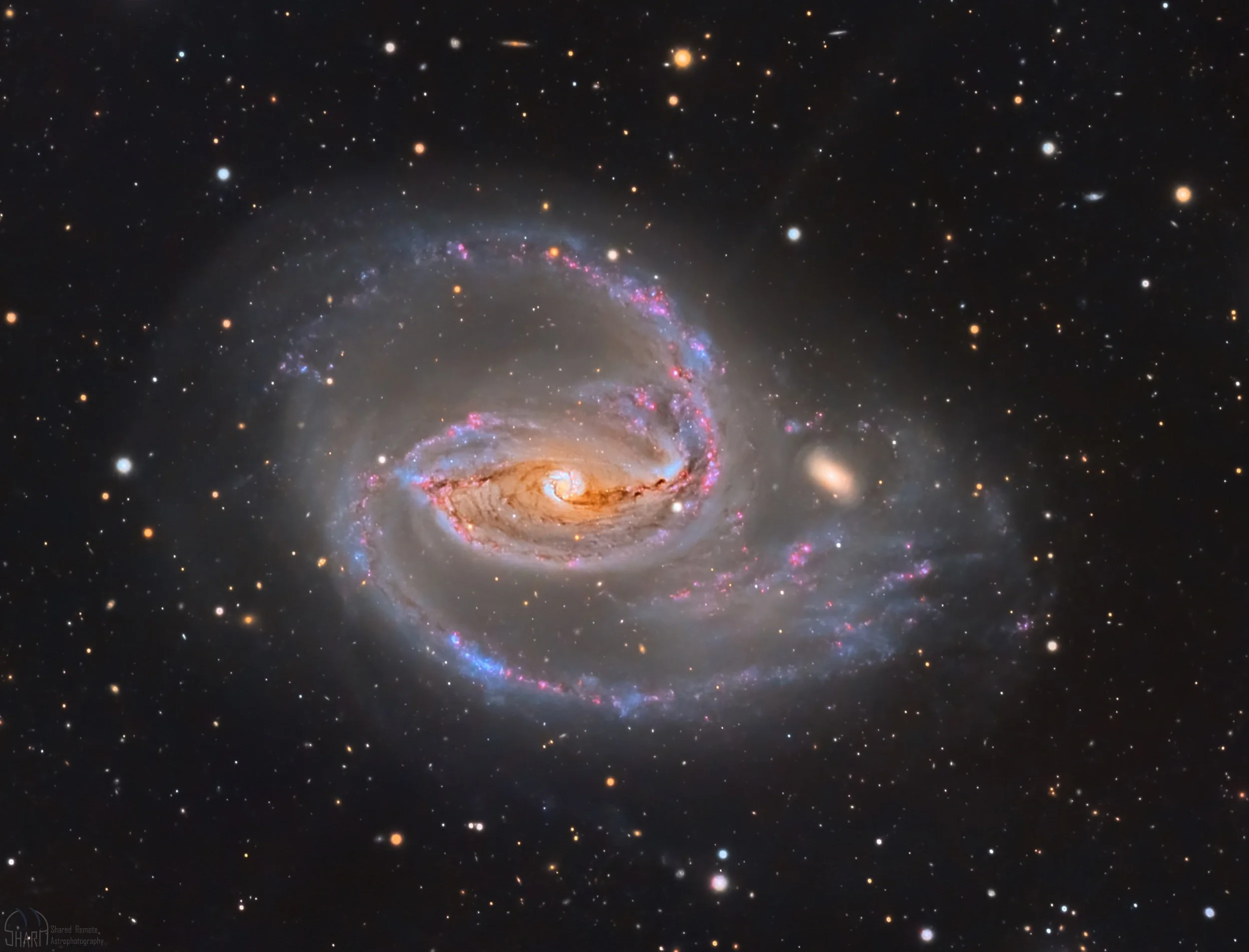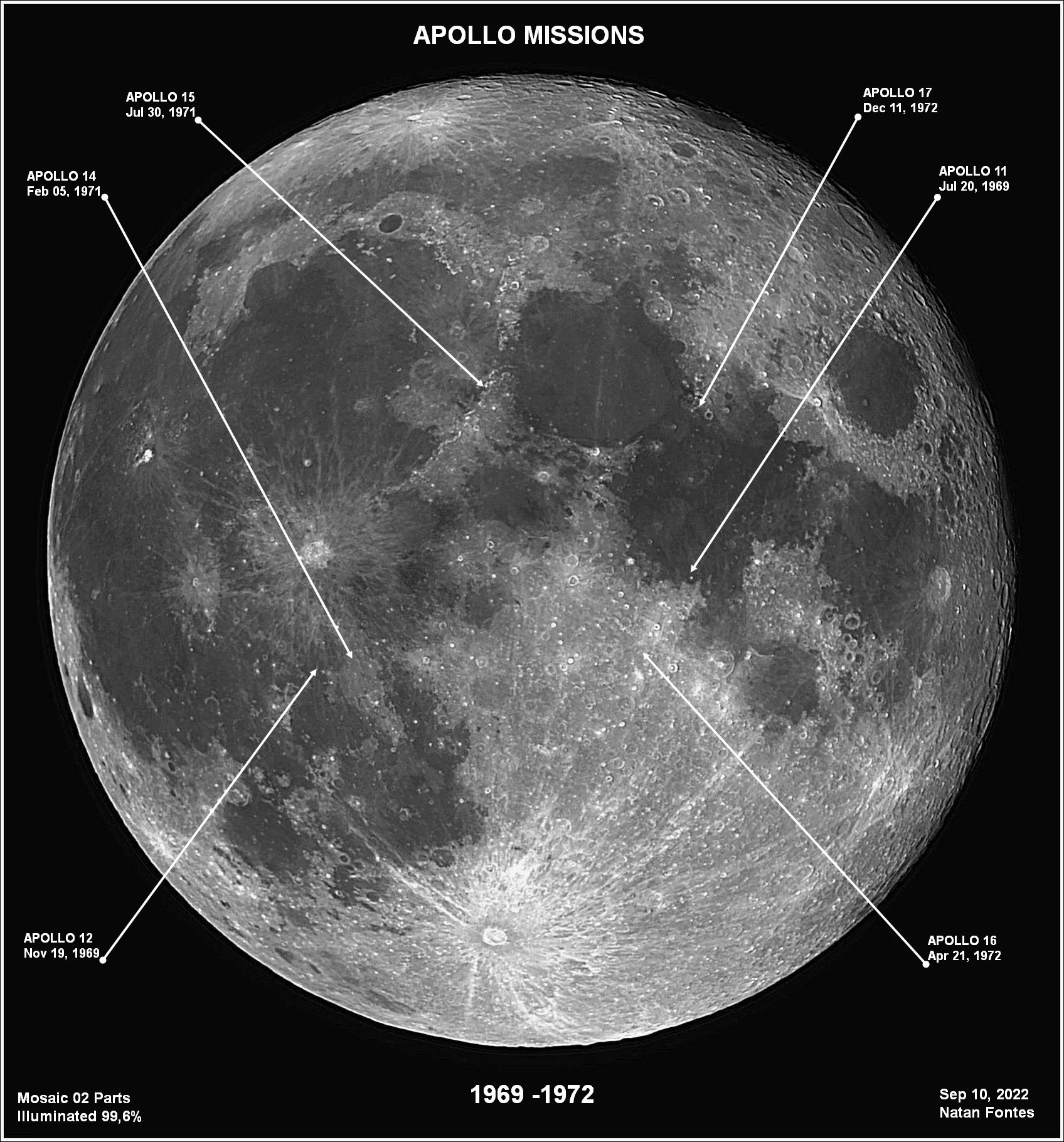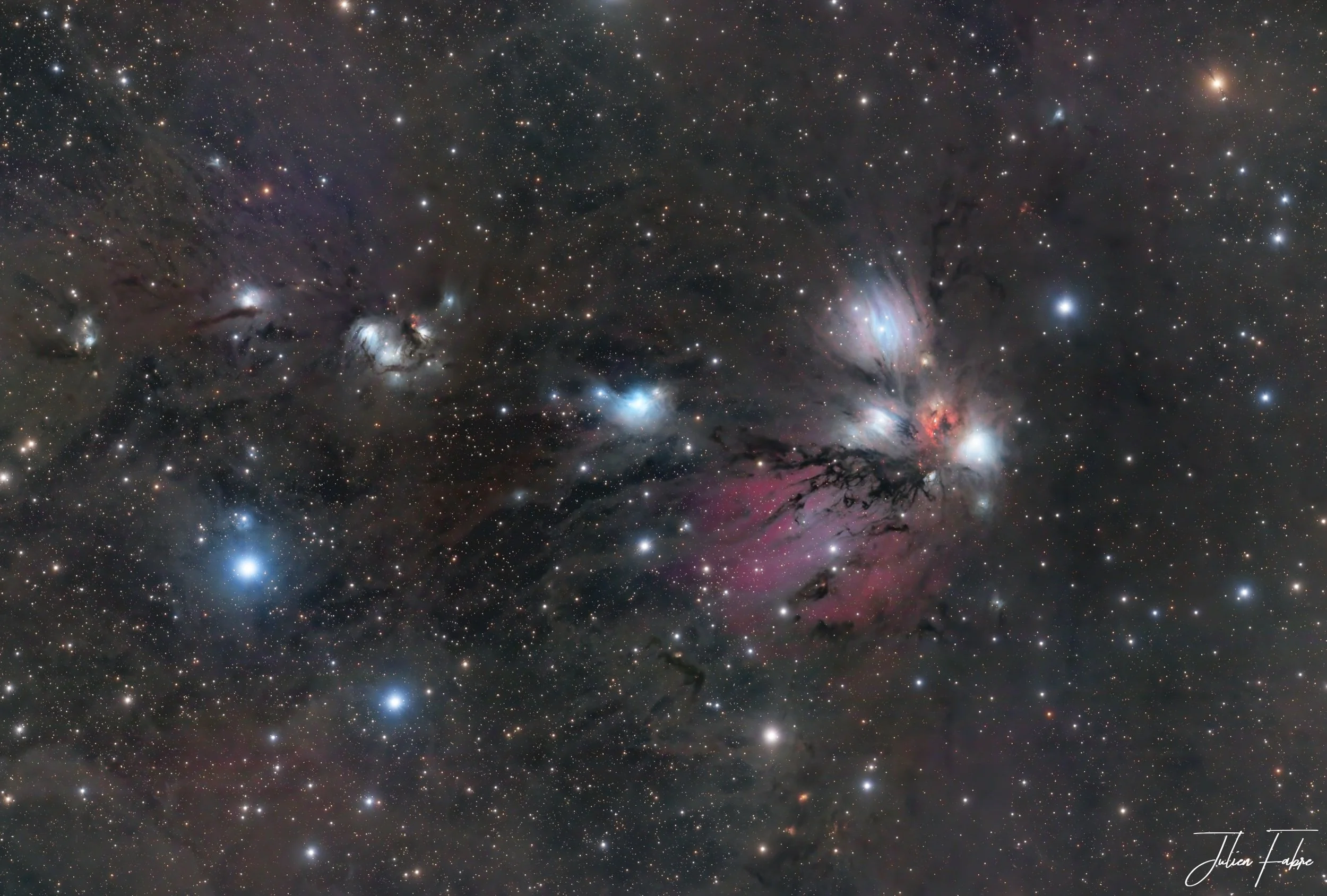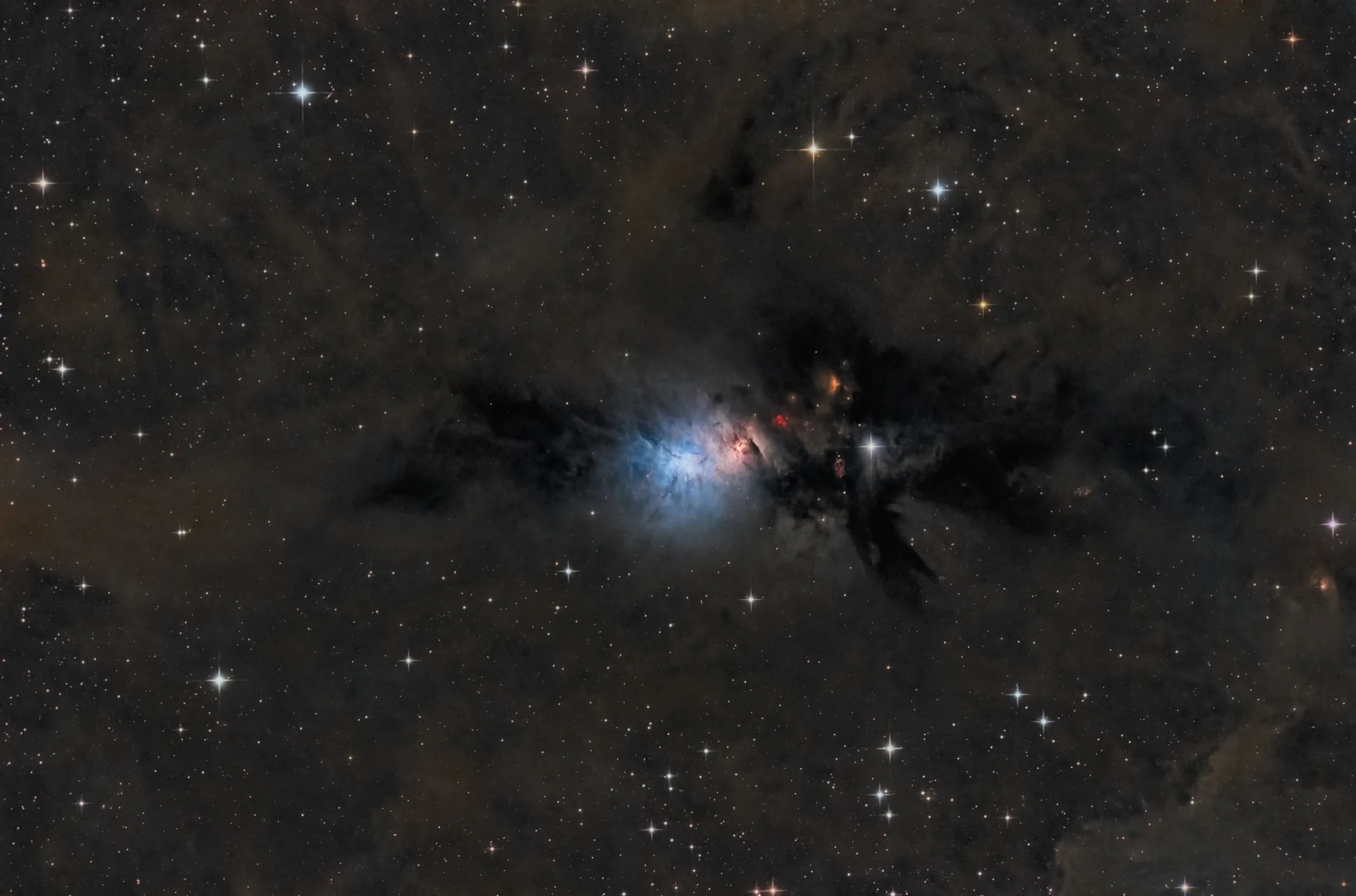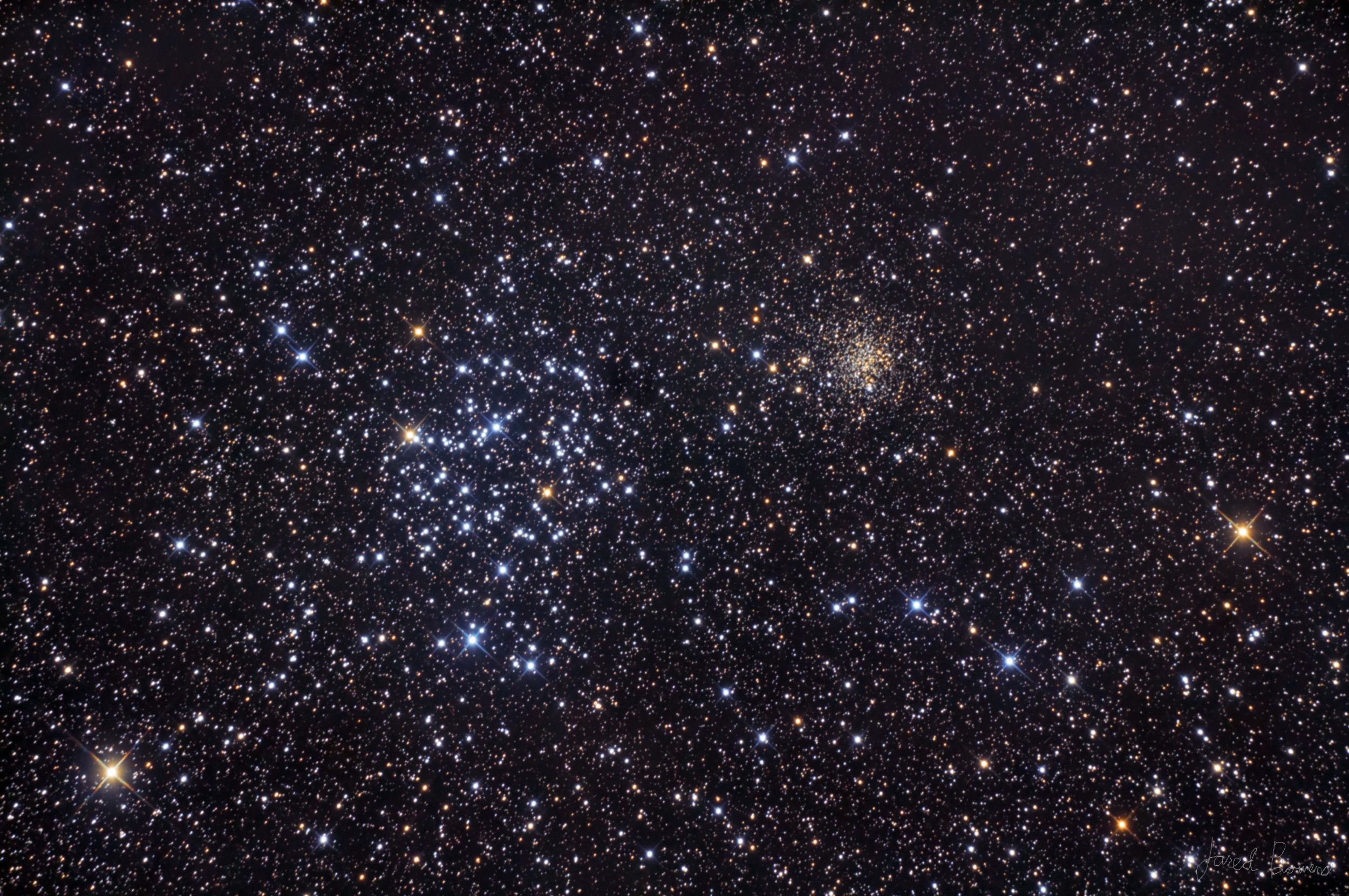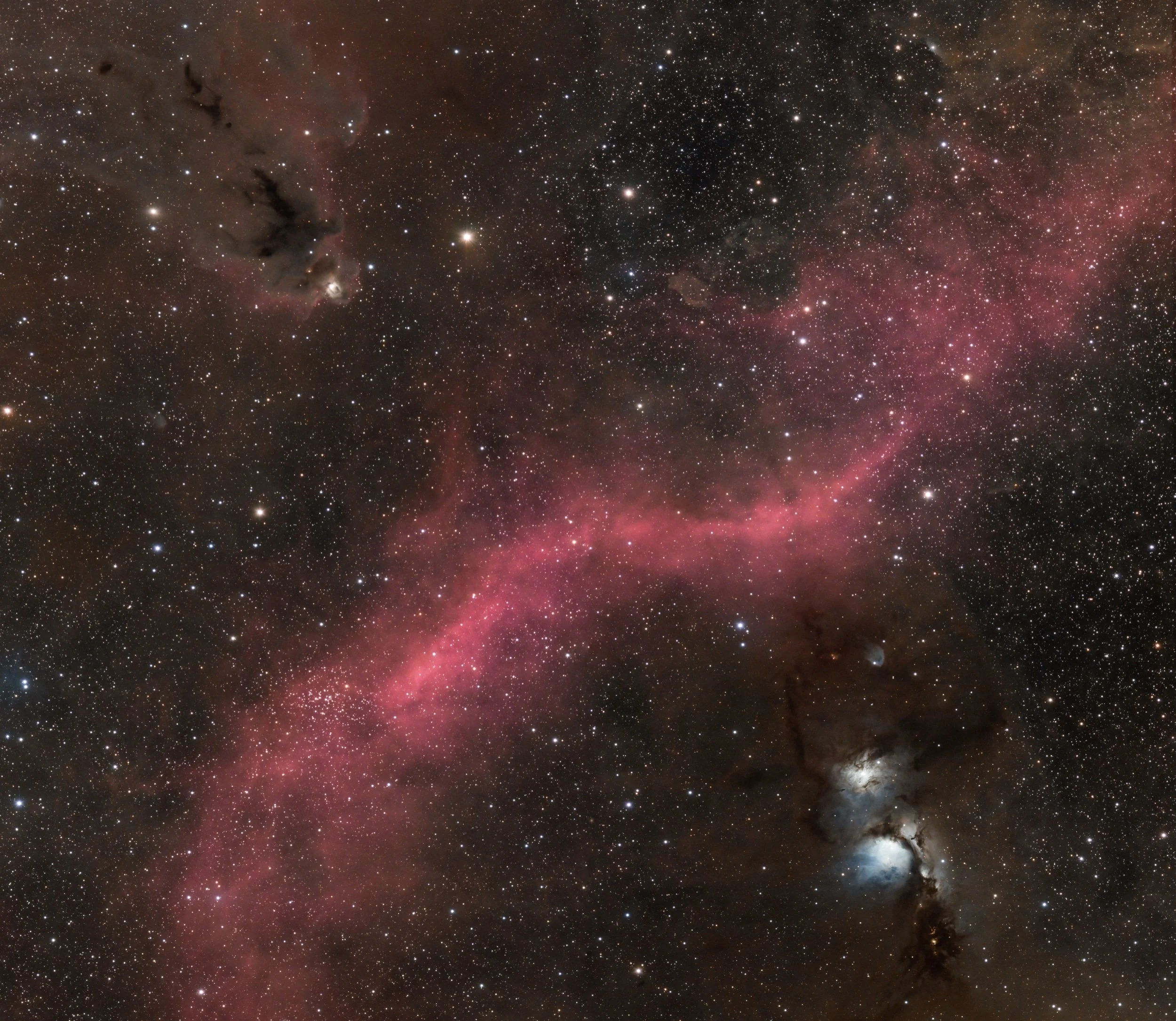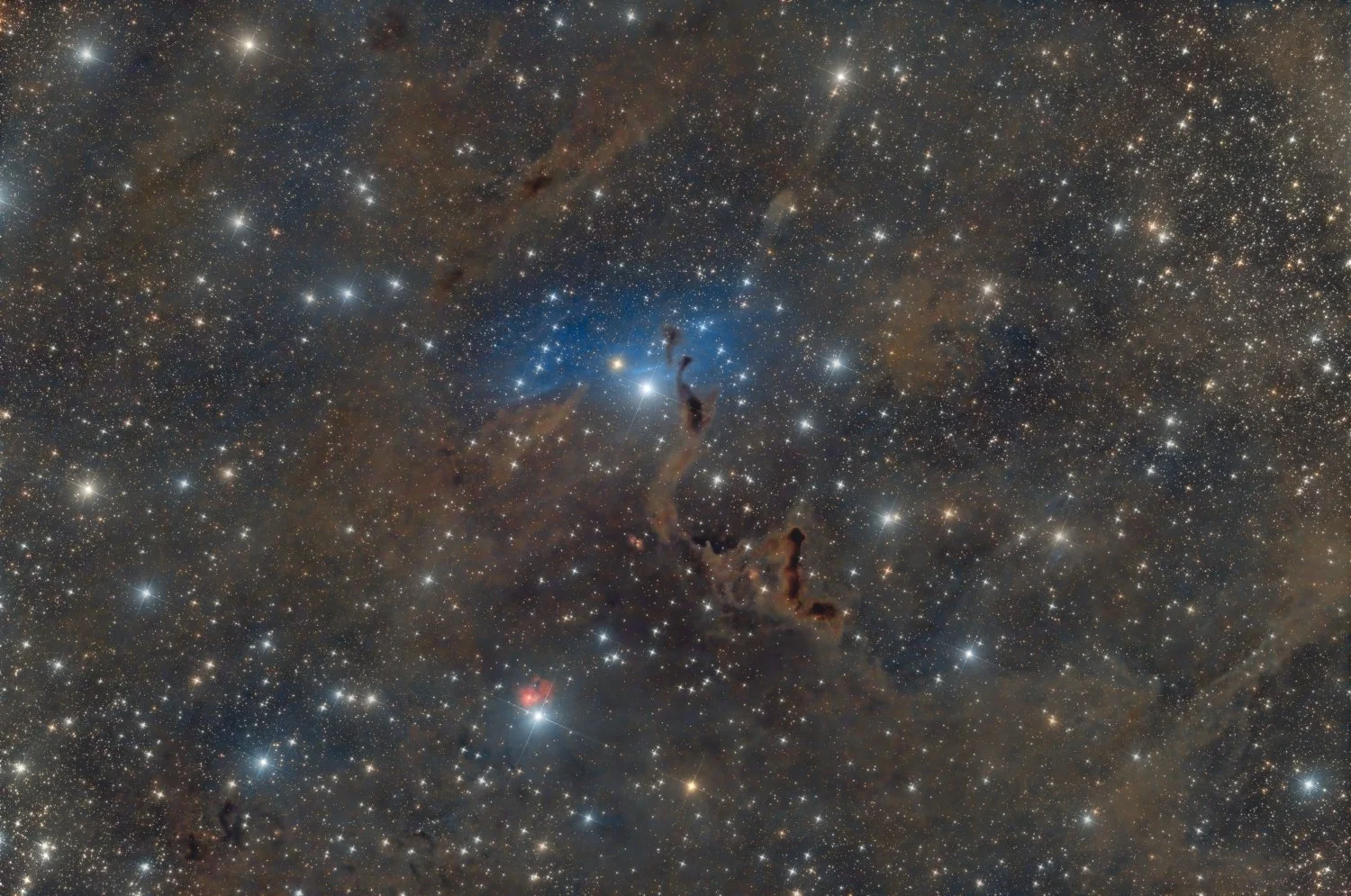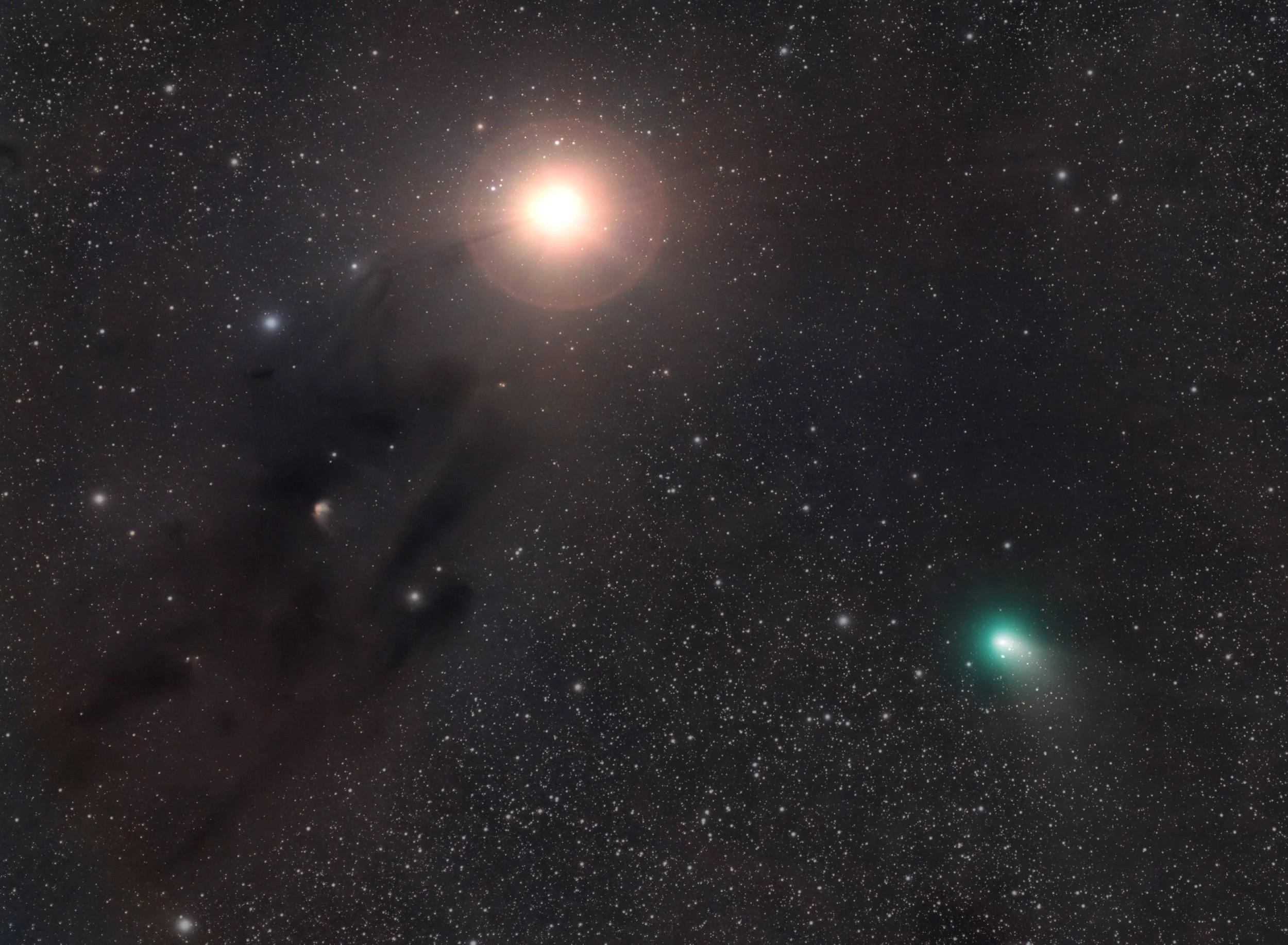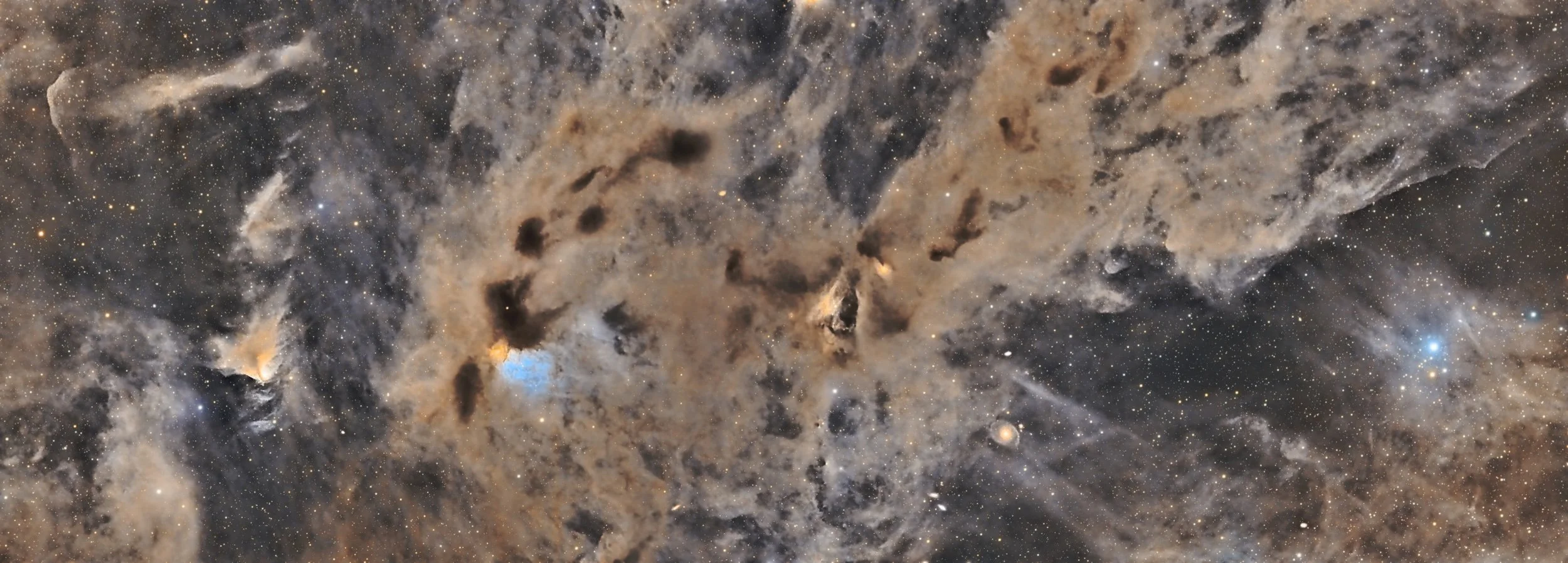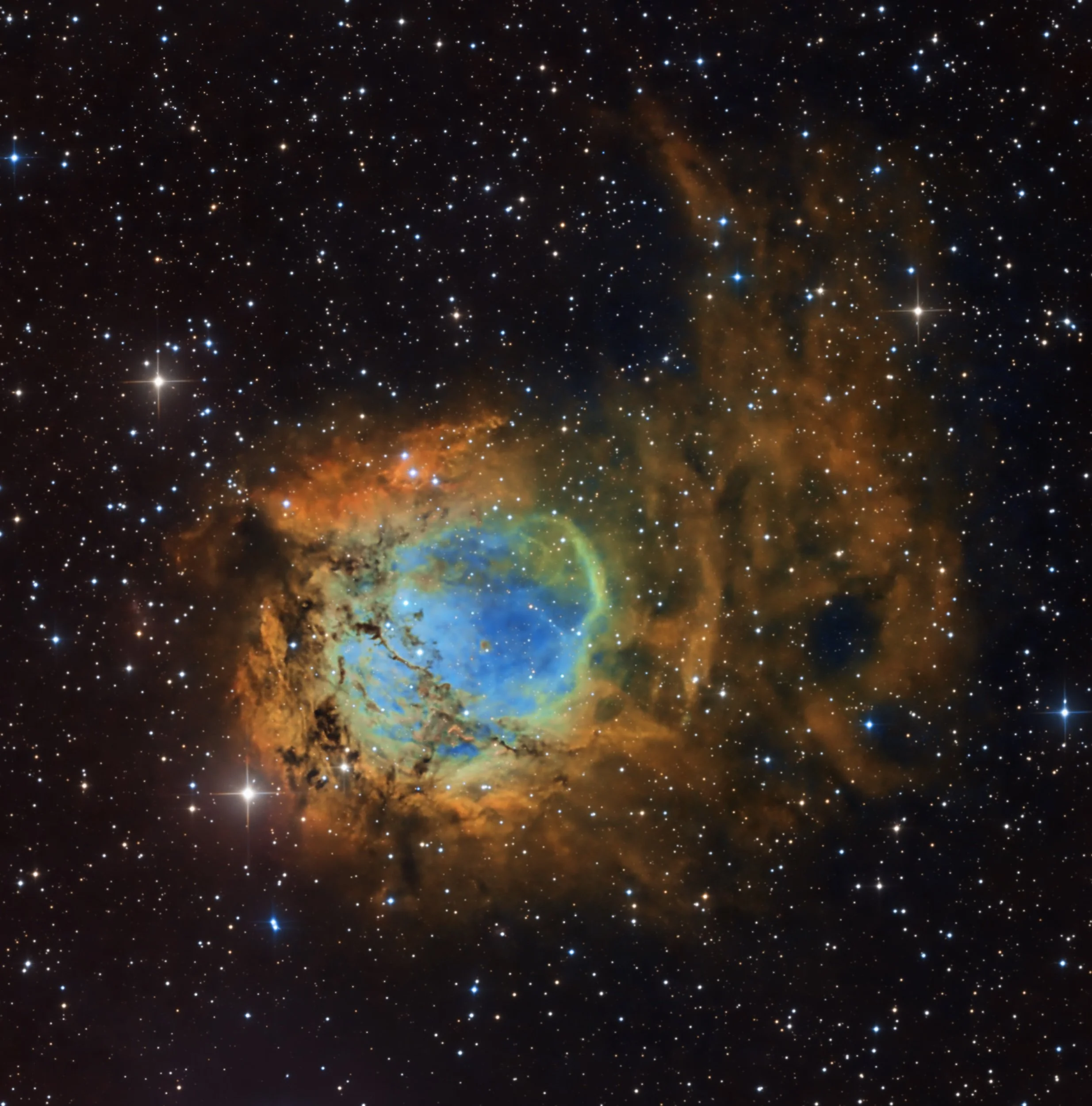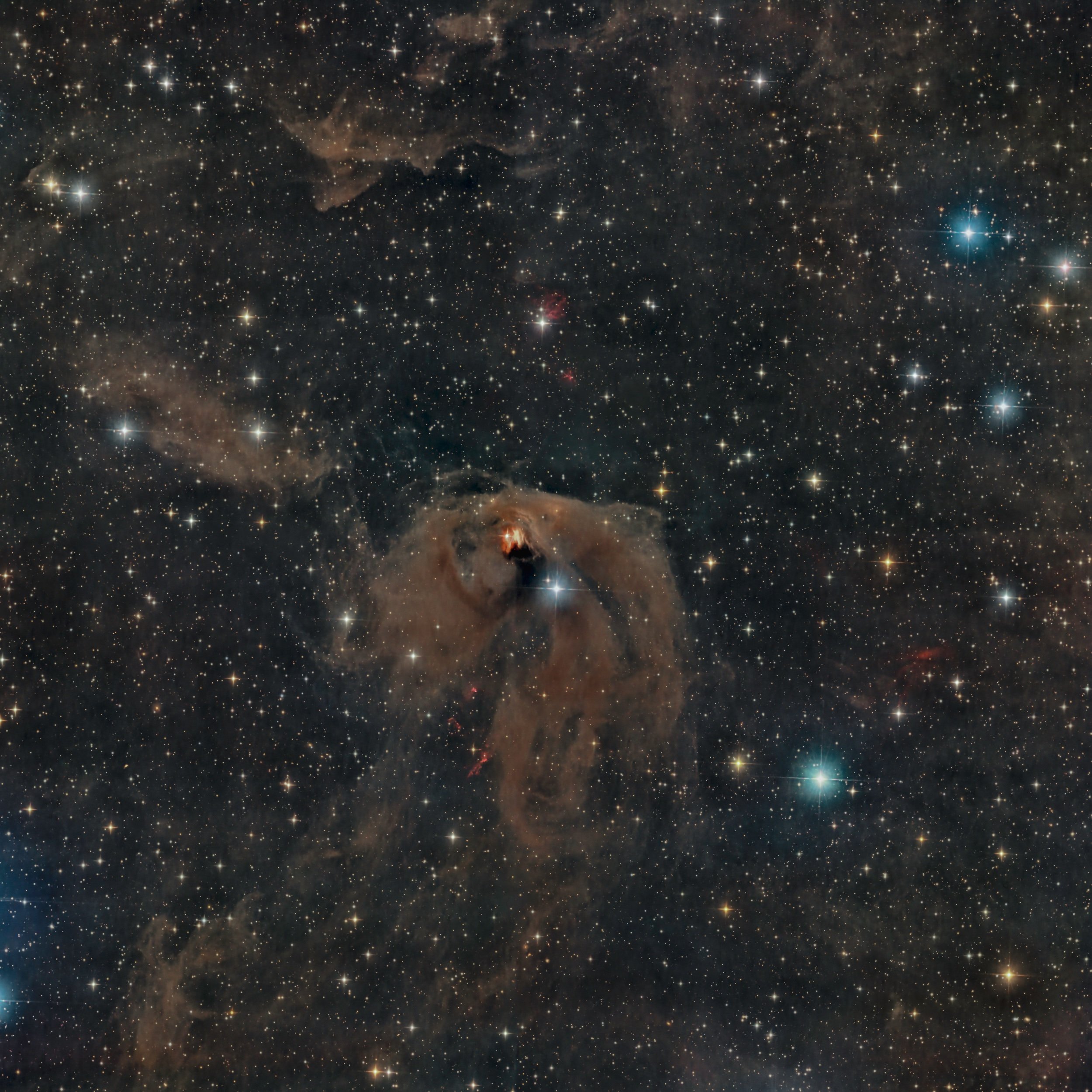
AAPOD2 Image Archives
The Eye of Horus - NGC-1097
Image Description and Details : NGC1097 is a splendid barred spiral galaxy, about 45 million light years away and located in the southern constellation of Fornax. It is cataloged as a Seyfert galaxy and at its center hosts a supermassive black hole that is devouring a few billion tons of matter every second.
The object is really interesting to photograph because it has many molecular hydrogen clouds (star formation zones), some of which are positioned in a circular shape right around the galactic center and spiraling around the black hole. The spiral shape is deformed due to the gravitational interaction with some neighboring galaxies: NGC1097A (embedded “perspectively” in one of the two arms) and NGC1097B (farther from the center).
Copyright: Massimo Di Fusco
APOLLO MISSIONS
Image Description and Details : The Moon has always fascinated humanity, for its beauty, size and phases.
In 1969, the man managed to walk on it and return safely, overcoming all the challenges of the time.
After this unprecedented landing, there were five more successful missions of manned landings, ending the Apollo Mission in 1972 with the landing of Apollo 17.
Today man is repairing himself to return to the Moon and continue his exploration of this precious satellite of ours.
This photo depicts the regions and dates of the six manned moon landings, symbolizing the golden period of lunar exploration, signaling future lunar explorations.
Technical Specification: Explore Scientific APO 80 mm Telescope; Baader IR685nm filter; ZWO ASI 290MM camera; AZEQ5 Sky-Watcher mount; Programs: FireCapture 2.6.08, AutoSakkert!3, Image Composite Editor, AstroSurface, RegiStax6, Affinitty Photo and IrfanView 64. Photo composed by mosaic of 02 panels.
Copyright: Natan Fontes
The angel nebula
Image Description and Details : NGC 2170 is a dusty reflection nebula and stellar nursery that formed about 8 million years ago, located at the edge of the giant star-forming molecular cloud Monoceros R2, some 2,700 light-years away. the constellation of Monoceros. The bluish areas are reflection nebulae, so named because they reflect light from nearby hot stars. The red areas are emission nebulae and glow because ultraviolet light from nearby stars excites hydrogen and other gas atoms in the nebula, which then emit their own light in specific colors. What looks a bit like black ink spread across the image are dark nebulae, and are only visible because of the light they block.
TSA120 and asi 2600mm
300 x 180s with L filter
45 x 180s on each rgb channel
Total: 21h45
Copyright: Julien FABRE
NGC 2029
Image Description and Details : This is a Narrowband image of NGC 2029, which is an area of emission nebulae in the LMC. This is a modified Sulphur II, Hydrogen Alpha, Oxygen III (SHO) image. The SHO combination, conventionally called the Hubble Palette, maps SII to Red, Ha to Green and OIII to Blue. It does however produce quite garish colours and pink stars.The mix is therefore often modified to give a more aesthetically pleasing image, but one where the abundance of the chemical species is still well mapped in a colour image. After some experimentation I went with:
Red: 50% SII + 50% Ha
Green: 20% Ha + 70% OIII
Blue: 100% OIII
I removed the stars with StarXTerminator, before processing the image. Previously I had removed the natural colour (RGB) stars in processing the LRGB image and I was able to use Pixel Math to add them back to this finished image, to give a much more pleasing star field.
The amazing tendrils of gas come through well in this version and I hope you like it, both for its scientific value in mapping the presence of Hydrogen, Oxygen and Sulphur in this region of the sky, but also for its aesthetics.
OTA: C11 EdgeHD
Camera: SBIG 16803
Mount: Paramount MEII
Filters: Astronomik 50mm RGB, Ha, OIII & SII
Exposures:
Ha: 17 x 1800 secs
OIII: 17 x 1800 secs
SII: 16 x 1800 secs
Red: 25 x 600 secs
Green: 24 x 600 secs
Blue: 24 x 600 secs
Total SHO integration: 25 hrs
Total RGB integration (stars): 12.2 hrs
Bias: 35
Darks: 35
Flats: 20
Copyright: Niall MacNeill
Solar prominence
Image Description and Details : My first solar image in 2023! A beautiful prominence was visible under difficult circumstances. I put the Earth into the image for a size comparison.
Equipment:
- Lichtenknecker 90/1350 refractor
- Coronado Solarmax 90 I (Ha-filter)
- ASI290MM
Image acquisition:
- 10000 frames capured at 170 fps
- Gain 0, 3.2 ms exposure time
Stacking and image processing:
- Stacking of the best 750 images in Autostakkert3
- Sharpening in Registax6
- Adding false colour in Photoshop, contrast, sharpness and brightness
Copyright: (c) Robert Schumann
M35 Clusters
Image Description and Details : Here’s a capture of two star clusters. The large open cluster on the left is M-35 is a relatively close open cluster of stars in the west of Gemini.
The smaller further away cluster is NGC-2158.
Taken with a 8 inch f3.9 orion newtonian astrograph, Canon 60d unmodified, AVX mount, orion starshoot autoguider 60mm guide scope
3 hours 3-minutes subs ISO-1250
Stacked with Deep sky stacker, Processed with pixlinsight: dynamic background, histrogram transformation, Noisexterminator, added luminous mask for experimental transform, added luminous mask for curve saturations. added star mask used morphologies transformations. Photoshop: selective color, contrast, levels adjustments.
Copyright: Jared Bowens
The Statue of Liberty Nebula - NGC 3576
Image Description and Details : Telescope: Sky-Watcher 250/1200 Black Diamond Reflector
Imaging Camera: ZWO ASI294MM Pro @ -10C, 121 Gain, Bin 2
Guide Camera: ZWO ASI290MM Mini + ZWO OAG
Mount: Sky-Watcher NEQ6 (Belt Mod + Hypertuned by Astronomy Academy Perth)
Filters: Astronomik 6nm Ha/Sii/Oiii + RGB
Acquisition details:
82x300s Ha
69x300s Oiii
67x300s Sii
40x30s RGB
Copyright: Daniel Faull
Barnard's Loop and cloud complex with M78 & LDN1622
Image Description and Details : Here is the area that includes M78 and LDN1622 separated by the Barnard loop.
This view offers us a magnificent mix of reflection nebula (M78), emission nebula (Barnard loop) and dark nebula (LDN1622).
Shooting information:
Place / date: La Fosse (Manhay, Belgium) - 13 & 14/02/2023
Constellation: ORION
Acquisition: 150 x 120 sec (05h00)
Mount: Skywatcher EQ6R pro
Optical tube: Celestron RASA 8
Camera: ZWO Asi2600MC (gain 100 / -20°)
Filter: None
Accessories: ZWO EAF - ZWO ASIAIR PRO
Processing: Siril - Pixinsight - Lightroom
Copyright: Werny Michael
NGC 1514
Image Description and Details : NGC 1514 is a planetary nebula in the constellation Taurus. It is also known as the Crystal Ball Nebula. It is 1520 light years from Earth. The nebula originated from a binary star system with the designation HD 281679 from the Henry Draper Catalogue. The bright, visible component is a giant star, while the nebula-generating companion is now a hot, sub-luminous O-type star. The two have one of the longest known orbits for any planetary nebula, with a period of about 9 years.
Captured on my remote observatory in Spain.
Scopes: APM TMB LZOS 152 Refractors
Cameras: QSI6120wsg8
Mounts: 10Micron GM2000 HPS
A total of 35 hours (HaOIIIRGB)
Copyright: Copyright: Peter Goodhew
LDN 1355
Image Description and Details: I present to you a dark nebula nicknamed LDN 1355 Located in the Constellation Cassiopeia, LDN 1355, together with the surrounding dark nebulae LDN 1357 and 1358, formed an interesting sight of an extended "helping hand". There is also a blue reflecting nebula VdB 9 lit by the star SU Cas. Then another reflective nebula VdB 7 with a hint of red and blue, surrounding a variable star RZ Cas.acquisitions: 413 exposures of 240s for a total of 27H30 Takahashi Epsilon 130DZWO ASI2600MC cameraL-pro filterIoptron mount CEM60-ECpixinsight and Photoshop processing Copyright: lamagat frederic
The Crab Nebula
Image Description and Details : The Crab Nebula (catalogue designations M1, NGC 1952, Taurus A) is a supernova remnant in the constellation of Taurus. Corresponding to a bright supernova recorded by Chinese astronomers in 1054, the nebula was observed later by English astronomer John Bevis in 1731. The nebula was the first astronomical object identified with a historical supernova explosion.
At an apparent magnitude of 8.4, comparable to that of Saturn's moon Titan, it is not visible to the naked eye but can be made out using binoculars under favourable conditions. The nebula lies in the Perseus Arm of the Milky Way galaxy, at a distance of about 6,500 ly from Earth. It has a diameter of 11 ly.
At the center of the nebula lies the Crab Pulsar, a neutron star 28–30 kilometres across with a spin rate of 30.2 times per second, which emits pulses of radiation from gamma rays to radio waves.
Copyright: Ruben Barbosa
Comet conjunction
Image Description and Details : I took this image in ruta b-55 near Antofagasta, Chile, with my astrophotography equipment. It was taken at 22:00 to 00:00 local time 10th february.
The objects in the frame are the comet ztf, mars, the dark nebula B22 (reflected a bit in mars halo) and ic 2087.
The equipment used was askar fra400 with his reducer (F3.9), zwo asi2600mm, astronomik lrgb filters and ioptron cem70.
The adquition details are:
L: 25 x 120”
R: 25 x 60”
G: 25 x 60”
B: 25 x 60”
Copyright: S. Emiliog
Lower’s Nebula
Image Description and Details : Sh2-261, also known as Lower’s Nebula (after Harold and Charles Lower discovered it in 1939), is an emission nebula found on the outermost edge of our Milkyway between the Orion and Perseus arm.
APM SD Apo (Fpl53) 140 F4,6 (644 mm)
ZWO ASI 533MC Pro + iOptron GEM45
Feb 2023
Optolong L-Ultimate (3 nm): 111X600"
Optolong Uv Ir cut: 30X60” (star color)
Tot: 19h
Modena (Sqm 18.3-18.9 Bortle 7,5-8), Italy
Copyright: Andrea Arbizzi
MOLECULAR CLOUDS ON TAURUS
Image Description and Details : 2 tiles composition of molecular clouds on Taurus. LRGB Image. FRANCISCO SERRANO & CARLOS LUNA
Francisco Serrano Setup:
- 121x120RGB per tile. Qhy294c, optolong uv/ir, zwo eaf, eq6r pro, sw esprit ed80, QHY 5P-IIC, Svbony SV165
Carlos Luna Setup:
- 180x120L with asi 1600mm, zwo efw 5 posiciones, RB focus Merlin, eq6pro, TS 80 photoline, reductor TS 0.79x, 8x50+qhy5llL, gaius S
Copyright: 2 tiles composition of molecular clouds on Taurus. LRGB Image. FRANCISCO SERRANO & CARLOS LUNA
Francisco Serrano Setup:
- 121x120RGB per tile. Qhy294c, optolong uv/ir, zwo eaf, eq6r pro, sw esprit ed80, QHY 5P-IIC, Svbony SV165
Carlos Luna Setup:
- 180x120L with asi 1600mm, zwo efw 5 posiciones, RB focus Merlin, eq6pro, TS 80 photoline, reductor TS 0.79x, 8x50+qhy5llL, gaius S
Name: FRANCISCO SERRANO
A 62-hour widefield image of Orion
Image Description and Details : This is easily one of my most ambitious astrophotography projects to date. Given that I’m fairly limited by my dslr in terms of imaging very dim objects, I decided to dump as much time on Orion as possible to see how much dust and gas in the region I could reveal. I was struck by how much wispy H-alpha gas didn’t line up exactly with the dust in the region – it was very cool to see the differences in ionized and non-ionized gas.
Equipment:
Nikon D800
200mm F4 lens
GEM 28
NINA
Nikonhacker
Acquisition
ISO 800, F4
Taken from a bortle 1 zone in Northwest CT
1240 x 180s (62 hours) – Taken on 12/18/2022, 12/20/2022, 12/21/2022, 12/22/2022, 12/23/2022, 12/24/2022, 12/27/2022, 1/18/2023, 1/21/2023, 1/22/2023, 1/23/2023. 1/24/2023
Copyright: William Ostling
SH2-301
Image Description and Details : This is an image of SH2-301. It is an emission and reflection nebula about 13,000 light years away in the constellation Canis Major.
Telescope: Planewave CDK-24
Camera: FLI PL9000
Mount: Mathis MI 1000/1250
Ha: 20x10 minutes (binned 1x1)
OIII: 20x10 minutes (binned 1x1)
SII: 20x10 minutes (binned 1x1)
Copyright: Bernard Miller
ngc 1555 Hind's nebula
Image Description and Details : NGC 1555, sometimes known as Hind's Variable Nebula, is a variable nebula, illuminated by the star T Tauri, located in the constellation Taurus. It is also in the second Sharpless catalogas 238. It is a Herbig–Haro object. The nebula was discovered on October 11, 1852, by John Russell Hind.
RC Astrosib 20" F2.7 + camera FLI 4040
CCDautopilot+the skyX + Pixinsight + Photoshop
Total RGB=18h40mn
From E-eye Fregenal de la sierra (Spain) in remote
Copyright: Georges Chassaigne
Gassendi, an amazing crater
Image Description and Details : Gassendi, an amazing crater.
Normally, when we start astrophotography, our first target is the Moon. Our old Lua is generous because it works well even on the most modest instruments. A simple 60mm scope and a cell phone already allow for interesting photos.
But shooting the moon in high resolution requires good apertures, proper collimation and a dedicated camera, and it can be difficult work if the photo is close to the terminator.
But, in fact, it is the photos close to the terminator that reveal the good lunar photographers, as they require adequate control of light, both at the time of capture and in subsequent processing.
In this photo we have Gassendi very close to the terminator, and with the sun at an extremely low angle, the relief of the floor stands out in a dazzling way. Its rhymes are usually very evident but with the sun low we can clearly see how irregular the floor of this remarkable crater is.
Gassendi is one of the main lunar craters, with its 114 km in diameter, it is very old formed in the Nectariam period about 3.92 billion years ago.
It is an impact crater with Fractured Interior (FFC), which was modified by volcanic action after its formation, probably huge lava flows gushed through the cracks in the floor, causing numerous stress fractures to form in its interior from the reservoirs. of lava, this made it quite shallow in relation to its diameter - just 2.8 km deep.
When observed through spectroscopic analysis, the Gassendi crater has a "behavior" very different from any other lunar crater (Mikhail 1979). High-resolution studies performed in near-infrared light (Chevrel and Pinet 1990, 1992) indicated the presence of extrusive volcanic material (that is volcanic material that flows to the surface and then crystallizes) limited to the adjacent southern part of the Gassendi floor. to the floor of the Mare Humorum.
Interpretation of the data also suggested that major extrusive volcanism may have occurred in the eastern portion of the floor, as indicated by the significant presence of pyroxene, which corresponds to visible volcanic features. The western part of the crater floor, away from the geometric continuation of the western rim of Mare Humorum, is composed of rich upland material.
The difference between the west and east sides of Gassendi with intensely fractured soil could be strongly linked to the early thermal history of Mare Humorum.
I've already taken countless photos of Gassendi, but the result of this one with the sun very low really surprised me. A pleasant surprise, which shows that each photo is unique in itself and each moment is unrecoverable if we don't know how to take advantage of it.
Copyright: Astroavani

